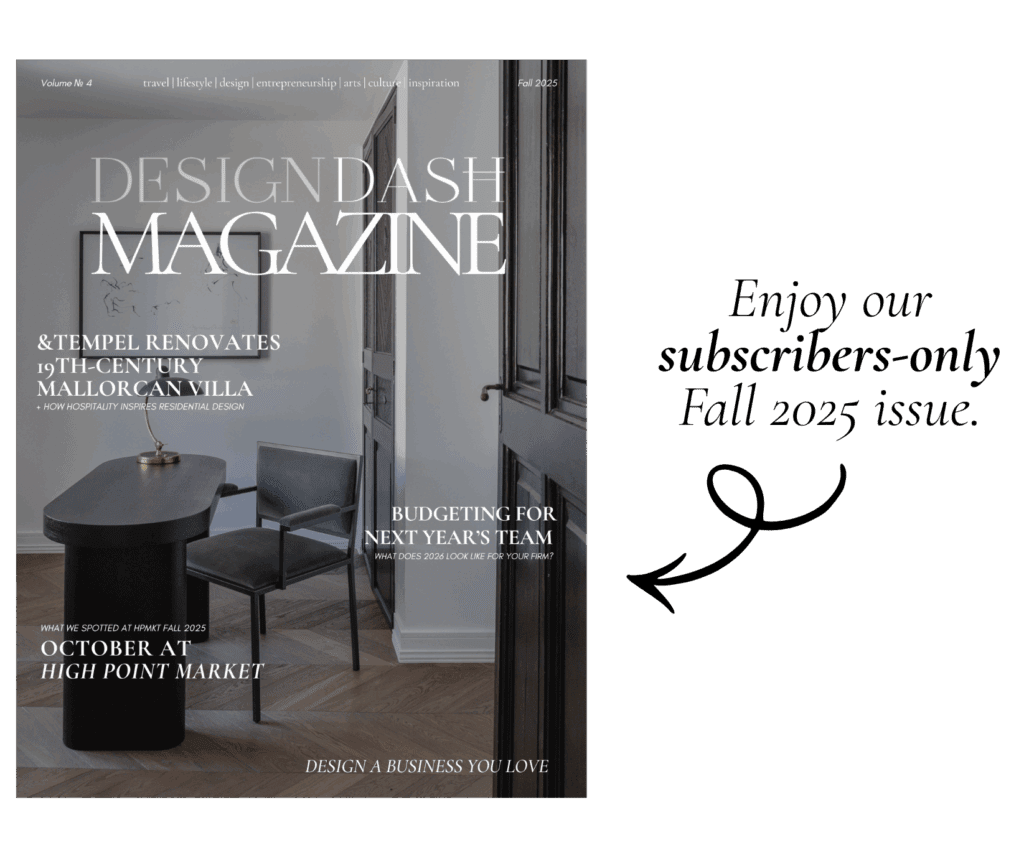
DesignDash Podcast: Client Red Flags That Cost You Time, Profit, and Peace
Summary
Not every client is a fit. The patterns present early: constant boundary-pushing, lack of respect for process, fixation on price, or timelines that ignore reality. Spotting these flags before contracts are signed—or resetting them midstream—saves your profit, your team’s energy, and the integrity of your work.
Reflection Questions
Which client behaviors in my past projects drained the most time, profit, or peace of mind—and did I see the signs early?
Do I have a clear, written framework for process, communication, and boundaries that filters out misaligned clients before the work begins?
How comfortable am I with ending an engagement that crosses the line, and what systems would make that exit feel clean rather than chaotic?
Journal Prompt
Think about the last project that left you frustrated or burned out. Write down the red flags that surfaced in the first meetings—what was said, what was skipped, what pushed your limits. Then sketch out how you would name, price, or decline those same behaviors today.
Interior designers read rooms for a living. Reading clients is just as important. The difference between discerning, demanding, and downright difficult shows up in your margins, your team’s morale, and the quality of the work that gets installed. Some pressure is part of the job; disrespect is not. Use this list to spot the patterns early, set firmer boundaries, and protect your studio’s best work. Listen to this episode of The DesignDash Podcast for more helpful tips!
Avoid These Client Red Flags That Cost You Time, Profit, and Peace!
They Don’t Respect Your Process

A solid process is the backbone of a design firm. When a prospective client insists you “skip steps,” pushes to bypass approvals, or wants you to source and install without documentation, you’re no longer running the project, your client is. That’s when mistakes multiply, budgets drift, and your team spends more time reacting than designing.
How to respond: lead with your map. Share a one-page project framework with milestones, decision points, and what you need from the client at each stage. Pair that with a communications guide (channels, response times, meeting cadence). If they bristle, you’ve learned something useful before you sign.
What the DesignDash founders say…
“A discerning client is coming to you because you do have a process and you can help them get what they’re looking for.” —Laura & Melissa
Boundary Bleed: All Hours, All Channels, All the Time
Late-night texts, “urgent” DMs, and a rapid-fire email thread before breakfast are more than annoyances—they’re signals that the relationship won’t respect time or focus. When your team is always on call, creative work suffers and burnout accelerates.
How to respond: set office hours and acceptable channels in writing; route everything through a shared project inbox or portal; and use an escalation rule (what’s truly urgent and how to reach you). Enforce it. The first exception becomes the new rule.
What the DesignDash founders say…
“When somebody’s contacting you 17 times in the course of 20 minutes… it’s just not sustainable.” —Laura & Melissa
Micromanagement That Creeps Into Control

Curious, engaged clients are great. Micromanagers stall projects, second-guess every line item, and pull you out of sequence. You’ll see it during discovery: they rewrite your intake, jump over steps, or want approval over conversations that should live within your team.
How to respond: define roles early (client decisions vs. designer decisions), present options in curated sets (not open-ended catalogs), and move choices into structured reviews with deadlines. Tie every decision back to the agreed scope and timeline.
What the DesignDash founders say…
“They might be micromanaging, which is so hard to deal with… and it can veer into toxic territory if there aren’t boundaries.” —Melissa
Disrespect, Demeaning Language, or “Gotcha” Behavior
The red line isn’t disagreement; it’s disrespect. You’ll hear it as sarcasm in meetings, belittling your team’s expertise, or treating vendors as expendable. Once it shows up, it rarely goes away.
How to respond: pause the project and reset the tone in writing. Name the behavior you won’t accept, outline communication expectations, and document consequences. If it continues, end the engagement—gracefully and promptly.
What the DesignDash founders say…
“The client crossing that line… they’re being disrespectful or demeaning. I cannot abide.” —Laura
Price-Only Talk (and Markup Myths)

Early conversations that fixate on “why is this so expensive,” “I could do this myself,” or “your markup is huge” are not minor quibbles; they’re values misalignment. If design fees, procurement, and project management aren’t seen as real work, you’ll argue your worth at every invoice.
How to respond: show your fee model, what it includes, and the risk you carry. Share a sample budget breakdown (design, furnishings, freight, install, contingency). If they still want wholesale pricing and concierge service, they’re not your client.
What the DesignDash founders say…
“It’s this kind of diminishing of the value we provide as interior designers. That’s the big one for me.” —Melissa
“All About the Money,” Not About the Outcome
Budget matters. But when a prospect only talks cost and never talks craft, lifestyle, or priorities, they won’t value the process that makes a home sing.
How to respond: reframe with trade-offs—scope, budget, timeline—pick two. If beauty and experience don’t make the cut in that conversation, bow out early.
What the DesignDash founders say…
“That’s a red flag for me… they don’t care about the process or the end experience. It’s about the money.” —Laura & Melissa
No Direct Access to the Decision Maker

You’re wooed by an assistant, property manager, or partner… and never meet the person whose name is on the checks. Then mid-project the gatekeeper disappears and the real stakeholder arrives with different tastes, rules, and timeline.
How to respond: require the decision maker in scope, concept, and budget approvals; add a clause for changes in representation; and schedule quarterly alignment meetings with all principals.
What the DesignDash founders say…
“We’ve dealt with an assistant or house manager… and then they move on—and now we get the client.” —Laura & Melissa
Fuel your creative fire & be a part of a supportive community that values how you love to live.
subscribe to our newsletter
*please check your Spam folder for the latest DesignDash Magazine issue immediately after subscription

Unrealistic Timelines and Event-Driven Pressure
“Install by September 1st for a 50th birthday.” “We need cabinetry in eight weeks.” External pressure is common. The flag appears when a client treats physics as optional and punishes the team for realities you didn’t create.
How to respond: offer two tracks—ideal and compressed—with the risks, premium costs, and scope cuts required. If they accept the compressed plan, document it. If they won’t accept trade-offs, protect your team and pass.
What the DesignDash founders say…
“It boils down to timing and budget—always. We’re here as your advocate, to problem-solve in realistic ways.” —Melissa
Refusal to Align After a Candid Reset

Projects wobble. Strong clients can regroup. The red flag is a client who refuses a clarity meeting, dodges hard truths, or demands outcomes that don’t match the path.
How to respond: host a reset meeting with a status snapshot (where we are), cause (how we got here), plan (what changes), and impact (time/cost). Follow with a written change order.
What the DesignDash founders say…
“Have the difficult conversation. Don’t sugarcoat it. Tell them why, then what you’re going to do about it.” —Laura
“Jump When I Say Jump”
Impatience isn’t new; entitlement is. Expecting immediate replies, demanding weekend site visits, or insisting that your team drops other clients signals a one-way street.
How to respond: publish response SLAs, block production time, and charge rush/after-hours premiums. If they won’t accept boundaries, they won’t accept outcomes.
What the DesignDash founders say…
“Not expecting a response two seconds after you sent it. Have boundaries.” —Laura
How to Redirect or Say “Goodbye” to Toxic Clients

The simplest way to protect your firm is to make red-flag management part of your process. Start by naming it early—use a fit checklist during discovery that covers decision makers, budget range, timeline realism, and respect for your process. Then put everything in writing, from your project map to communication guidelines, meeting cadence, and change-order policy.
When pressure builds, price it accordingly with rush fees, weekend premiums, or compressed-schedule surcharges. If a project starts to wobble, use a reset: show the current status, explain why it happened, outline the plan, and define the impact before issuing a change order. And if the relationship still won’t align, exit cleanly with clear contract language, written notice, a tidy handoff, and a closed loop with your team.
Building a Client Roster You’re Proud Of
You can handle demanding. You can do timelines. You excel at complex projects. What you don’t have to accept is disrespect, scope chaos, or a relationship that costs your sanity. Read the flags, act early, and back your process.
Have more questions about the business side of design that nobody covered in school? Join the DesignDash Community for access to peers who are growing, questioning, and succeeding right alongside you.
Written by the DesignDash Editorial Team
Our contributors include experienced designers, firm owners, design writers, and other industry professionals. If you’re interested in submitting your work or collaborating, please reach out to our Editor-in-Chief at editor@designdash.com.











